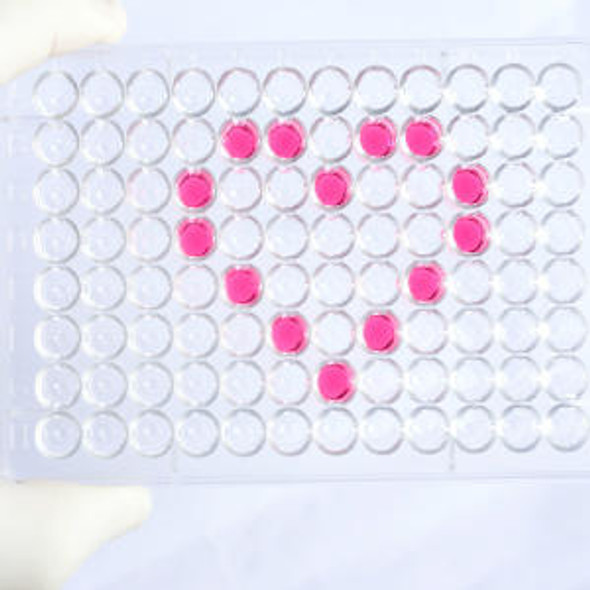Human AKT1 ELISA Kit
- SKU:
- HUFI00382
- Product Type:
- ELISA Kit
- Size:
- 96 Assays
- Uniprot:
- P31749
- Sensitivity:
- 0.094ng/ml
- Range:
- 0.156-10ng/ml
- ELISA Type:
- Sandwich ELISA, Double Antibody
- Synonyms:
- PKB, AKT1, PKB alpha, PRKBA, RAC-alpha, AKT, PKBMGC99656, Protein kinase B, Proto-oncogene c-Akt, rac protein kinase alpha, RAC-ALPHA, RAC-alpha serine, threonine-protein kinase, RAC-PK-alpha, RACPKB-ALPHA, v-akt murine thymoma viral oncogene homolog
- Reactivity:
- Human
Description
| Product Name: | Human AKT1 ELISA Kit |
| Product Code: | HUFI00382 |
| Size: | 96 Assays |
| Alias: | PKB, AKT1, PKB alpha, PRKBA, RAC-alpha, AKT, PKBMGC99656, Protein kinase B, Proto-oncogene c-Akt, rac protein kinase alpha, RAC-ALPHA, RAC-alpha serine, threonine-protein kinase, RAC-PK-alpha, RACPKB-ALPHA, v-akt murine thymoma viral oncogene homolog 1 |
| Detection method: | Sandwich ELISA, Double Antibody |
| Application: | This immunoassay kit allows for the in vitro quantitative determination of Human AKT1 concentrations in serum plasma and other biological fluids. |
| Sensitivity: | 0.094ng/ml |
| Range: | 0.156-10ng/ml |
| Storage: | 4°C for 6 months |
| Note: | For Research Use Only |
| Recovery: | Matrices listed below were spiked with certain level of Human AKT1 and the recovery rates were calculated by comparing the measured value to the expected amount of Human AKT1 in samples. | ||||||||||||||||
| |||||||||||||||||
| Linearity: | The linearity of the kit was assayed by testing samples spiked with appropriate concentration of Human AKT1 and their serial dilutions. The results were demonstrated by the percentage of calculated concentration to the expected. | ||||||||||||||||
| |||||||||||||||||
| CV(%): | Intra-Assay: CV<8% Inter-Assay: CV<10% |
| Component | Quantity | Storage |
| ELISA Microplate (Dismountable) | 8×12 strips | 4°C for 6 months |
| Lyophilized Standard | 2 | 4°C/-20°C |
| Sample/Standard Dilution Buffer | 20ml | 4°C |
| Biotin-labeled Antibody(Concentrated) | 120ul | 4°C (Protect from light) |
| Antibody Dilution Buffer | 10ml | 4°C |
| HRP-Streptavidin Conjugate(SABC) | 120ul | 4°C (Protect from light) |
| SABC Dilution Buffer | 10ml | 4°C |
| TMB Substrate | 10ml | 4°C (Protect from light) |
| Stop Solution | 10ml | 4°C |
| Wash Buffer(25X) | 30ml | 4°C |
| Plate Sealer | 5 | - |
Other materials and equipment required:
- Microplate reader with 450 nm wavelength filter
- Multichannel Pipette, Pipette, microcentrifuge tubes and disposable pipette tips
- Incubator
- Deionized or distilled water
- Absorbent paper
- Buffer resevoir
| Uniprot | P31749 |
| UniProt Protein Function: | Akt1: an oncogenic AGC kinase that plays a critical role in regulating cell survival and metabolism in many different signaling pathways. Dual phosphorylation is required for its activation. T308 is phosphorylated by PDK1 in the PI3 kinase pathway, and S473 is phosphorylated by mTOR in the mTORC2 pathway. The 'Lys-63'-linked ubiquitination of AKT1 by TRAF6 is important for its translocation to the plasma membrane, phosphorylation, and activation. When Akt is fully phosphorylated it translocates into the nucleus, undergoes 'Lys-48'-polyubiquitination catalyzed by TTC3, leading to its proteosomal degradation. Hyperactive or overexpressed in a number of cancers including breast, prostate, lung, pancreatic, liver, ovarian and colorectal. Over 160 protein substrates are known including many that regulate transcription, metabolism, apoptosis, cell cycle, and growth. |
| UniProt Protein Details: | Protein type:AGC group; AKT family; EC 2.7.11.1; Kinase, protein; Oncoprotein; Protein kinase, AGC; Protein kinase, Ser/Thr (non-receptor) Chromosomal Location of Human Ortholog: 14q32.33 Cellular Component: cytoplasm; cytosol; microtubule cytoskeleton; nucleoplasm; nucleus; plasma membrane; vesicle Molecular Function:ATP binding; enzyme binding; identical protein binding; kinase activity; nitric-oxide synthase regulator activity; phosphatidylinositol-3,4,5-triphosphate binding; phosphatidylinositol-3,4-bisphosphate binding; protein binding; protein kinase activity; protein serine/threonine kinase activity; protein serine/threonine/tyrosine kinase activity Biological Process: activated T cell apoptosis; cell differentiation; cell proliferation; cellular response to insulin stimulus; endocrine pancreas development; G-protein coupled receptor protein signaling pathway; G1/S-specific positive regulation of cyclin-dependent protein kinase activity; insulin receptor signaling pathway; insulin-like growth factor receptor signaling pathway; negative regulation of apoptosis; negative regulation of autophagy; negative regulation of caspase activity; negative regulation of fatty acid beta-oxidation; negative regulation of protein kinase activity; negative regulation of proteolysis; nitric oxide biosynthetic process; peptidyl-serine phosphorylation; peptidyl-threonine phosphorylation; phosphoinositide-mediated signaling; phosphorylation; platelet activation; positive regulation of blood vessel endothelial cell migration; positive regulation of cell growth; positive regulation of cellular protein metabolic process; positive regulation of endodeoxyribonuclease activity; positive regulation of endothelial cell proliferation; positive regulation of epidermal growth factor receptor signaling pathway; positive regulation of fat cell differentiation; positive regulation of glucose import; positive regulation of glycogen biosynthetic process; positive regulation of lipid biosynthetic process; positive regulation of nitric oxide biosynthetic process; positive regulation of nitric-oxide synthase activity; positive regulation of peptidyl-serine phosphorylation; positive regulation of protein amino acid phosphorylation; positive regulation of smooth muscle cell proliferation; positive regulation of transcription factor activity; protein amino acid autophosphorylation; protein amino acid phosphorylation; protein import into nucleus, translocation; protein modification process; regulation of cell migration; regulation of glycogen biosynthetic process; regulation of mRNA stability; regulation of nitric-oxide synthase activity; regulation of phosphoinositide 3-kinase cascade; response to heat; response to oxidative stress; signal transduction; T cell costimulation Disease: Breast Cancer; Colorectal Cancer; Cowden Syndrome 6; Ovarian Cancer; Proteus Syndrome; Schizophrenia |
| NCBI Summary: | The serine-threonine protein kinase encoded by the AKT1 gene is catalytically inactive in serum-starved primary and immortalized fibroblasts. AKT1 and the related AKT2 are activated by platelet-derived growth factor. The activation is rapid and specific, and it is abrogated by mutations in the pleckstrin homology domain of AKT1. It was shown that the activation occurs through phosphatidylinositol 3-kinase. In the developing nervous system AKT is a critical mediator of growth factor-induced neuronal survival. Survival factors can suppress apoptosis in a transcription-independent manner by activating the serine/threonine kinase AKT1, which then phosphorylates and inactivates components of the apoptotic machinery. Mutations in this gene have been associated with the Proteus syndrome. Multiple alternatively spliced transcript variants have been found for this gene. [provided by RefSeq, Jul 2011] |
| UniProt Code: | P31749 |
| NCBI GenInfo Identifier: | 60391226 |
| NCBI Gene ID: | 207 |
| NCBI Accession: | P31749.2 |
| UniProt Secondary Accession: | P31749,Q9BWB6, B2RAM5, B7Z5R1, |
| UniProt Related Accession: | P31749 |
| Molecular Weight: | 48,347 Da |
| NCBI Full Name: | RAC-alpha serine/threonine-protein kinase |
| NCBI Synonym Full Names: | AKT serine/threonine kinase 1 |
| NCBI Official Symbol: | AKT1 |
| NCBI Official Synonym Symbols: | AKT; PKB; RAC; CWS6; PRKBA; PKB-ALPHA; RAC-ALPHA |
| NCBI Protein Information: | RAC-alpha serine/threonine-protein kinase |
| UniProt Protein Name: | RAC-alpha serine/threonine-protein kinase |
| UniProt Synonym Protein Names: | Protein kinase B; PKB; Protein kinase B alpha; PKB alpha; Proto-oncogene c-Akt; RAC-PK-alpha |
| Protein Family: | AKT-interacting protein |
| UniProt Gene Name: | AKT1 |
*Note: Protocols are specific to each batch/lot. For the correct instructions please follow the protocol included in your kit.
Before adding to wells, equilibrate the SABC working solution and TMB substrate for at least 30 min at 37°C. When diluting samples and reagents, they must be mixed completely and evenly. It is recommended to plot a standard curve for each test.
| Step | Protocol |
| 1. | Set standard, test sample and control (zero) wells on the pre-coated plate respectively, and then, record their positions. It is recommended to measure each standard and sample in duplicate. Wash plate 2 times before adding standard, sample and control (zero) wells! |
| 2. | Aliquot 0.1ml standard solutions into the standard wells. |
| 3. | Add 0.1 ml of Sample / Standard dilution buffer into the control (zero) well. |
| 4. | Add 0.1 ml of properly diluted sample ( Human serum, plasma, tissue homogenates and other biological fluids.) into test sample wells. |
| 5. | Seal the plate with a cover and incubate at 37 °C for 90 min. |
| 6. | Remove the cover and discard the plate content, clap the plate on the absorbent filter papers or other absorbent material. Do NOT let the wells completely dry at any time. Wash plate X2. |
| 7. | Add 0.1 ml of Biotin- detection antibody working solution into the above wells (standard, test sample & zero wells). Add the solution at the bottom of each well without touching the side wall. |
| 8. | Seal the plate with a cover and incubate at 37°C for 60 min. |
| 9. | Remove the cover, and wash plate 3 times with Wash buffer. Let wash buffer rest in wells for 1 min between each wash. |
| 10. | Add 0.1 ml of SABC working solution into each well, cover the plate and incubate at 37°C for 30 min. |
| 11. | Remove the cover and wash plate 5 times with Wash buffer, and each time let the wash buffer stay in the wells for 1-2 min. |
| 12. | Add 90 µl of TMB substrate into each well, cover the plate and incubate at 37°C in dark within 10-20 min. (Note: This incubation time is for reference use only, the optimal time should be determined by end user.) And the shades of blue can be seen in the first 3-4 wells (with most concentrated standard solutions), the other wells show no obvious color. |
| 13. | Add 50 µl of Stop solution into each well and mix thoroughly. The color changes into yellow immediately. |
| 14. | Read the O.D. absorbance at 450 nm in a microplate reader immediately after adding the stop solution. |
When carrying out an ELISA assay it is important to prepare your samples in order to achieve the best possible results. Below we have a list of procedures for the preparation of samples for different sample types.
| Sample Type | Protocol |
| Serum | If using serum separator tubes, allow samples to clot for 30 minutes at room temperature. Centrifuge for 10 minutes at 1,000x g. Collect the serum fraction and assay promptly or aliquot and store the samples at -80°C. Avoid multiple freeze-thaw cycles. If serum separator tubes are not being used, allow samples to clot overnight at 2-8°C. Centrifuge for 10 minutes at 1,000x g. Remove serum and assay promptly or aliquot and store the samples at -80°C. Avoid multiple freeze-thaw cycles. |
| Plasma | Collect plasma using EDTA or heparin as an anticoagulant. Centrifuge samples at 4°C for 15 mins at 1000 × g within 30 mins of collection. Collect the plasma fraction and assay promptly or aliquot and store the samples at -80°C. Avoid multiple freeze-thaw cycles. Note: Over haemolysed samples are not suitable for use with this kit. |
| Urine & Cerebrospinal Fluid | Collect the urine (mid-stream) in a sterile container, centrifuge for 20 mins at 2000-3000 rpm. Remove supernatant and assay immediately. If any precipitation is detected, repeat the centrifugation step. A similar protocol can be used for cerebrospinal fluid. |
| Cell culture supernatant | Collect the cell culture media by pipette, followed by centrifugation at 4°C for 20 mins at 1500 rpm. Collect the clear supernatant and assay immediately. |
| Cell lysates | Solubilize cells in lysis buffer and allow to sit on ice for 30 minutes. Centrifuge tubes at 14,000 x g for 5 minutes to remove insoluble material. Aliquot the supernatant into a new tube and discard the remaining whole cell extract. Quantify total protein concentration using a total protein assay. Assay immediately or aliquot and store at ≤ -20 °C. |
| Tissue homogenates | The preparation of tissue homogenates will vary depending upon tissue type. Rinse tissue with 1X PBS to remove excess blood & homogenize in 20ml of 1X PBS (including protease inhibitors) and store overnight at ≤ -20°C. Two freeze-thaw cycles are required to break the cell membranes. To further disrupt the cell membranes you can sonicate the samples. Centrifuge homogenates for 5 mins at 5000xg. Remove the supernatant and assay immediately or aliquot and store at -20°C or -80°C. |
| Tissue lysates | Rinse tissue with PBS, cut into 1-2 mm pieces, and homogenize with a tissue homogenizer in PBS. Add an equal volume of RIPA buffer containing protease inhibitors and lyse tissues at room temperature for 30 minutes with gentle agitation. Centrifuge to remove debris. Quantify total protein concentration using a total protein assay. Assay immediately or aliquot and store at ≤ -20 °C. |
| Breast Milk | Collect milk samples and centrifuge at 10,000 x g for 60 min at 4°C. Aliquot the supernatant and assay. For long term use, store samples at -80°C. Minimize freeze/thaw cycles. |










